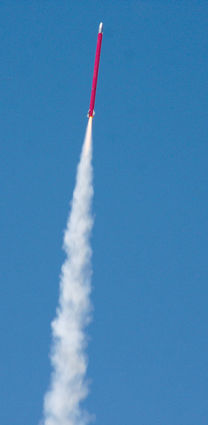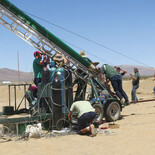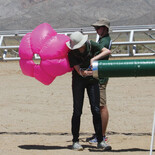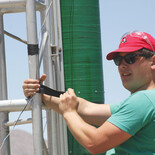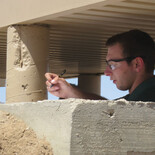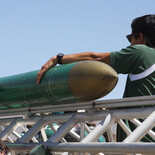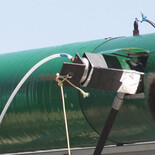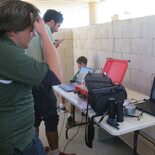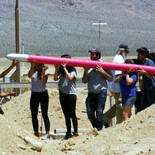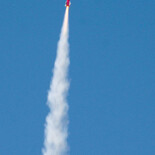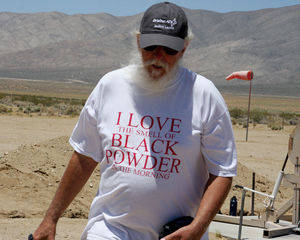Rocket test site near Cantil offers amateurs, students space and time to fire their projects
The Forde Files No. 171
June 9, 2018
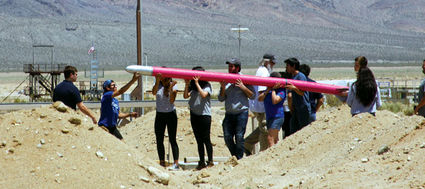
Tina Fisher Cunningham
Citrus Community College students carry their solid-fuel vehicle to the launch rail.
Members of the California State University, San Luis Obispo, Cal Poly Space Systems rocketry club had high hopes for its "HM-7 heavy" – a 15.08-foot-long, hybrid motor, 150-pound vehicle named The Kronheim Rocket after a former faculty advisor.
They had been working on the beast for two years, refining the valves, the pressures, the ignition and fuel mixtures, the connections, the design. Except for two government-mandated pressure vessels, they had fabricated and machined every part of the rocket. The hybrid rocket uses liquid nitrous oxide (laughing gas) as its oxygen source and hydroxyl-terminated polybutadiene (HTPB – also known as rubber) for fuel.
While keeping up their grades in aerospace engineering, avionics, physics and other disciplines, club members dedicate much of their lives to the rocket project. Funding is minimal.
"We have a $20,000 budget for design, test and launch of the rocket," faculty advisor aerospace professor Dr. Amelia Greig said. "We can do it but it's tight."
There's the occasional $5,000 grant, she said, and Lockheed Martin is a regular sponsor along with a few other aerospace companies. The name Penguin Computing appears between the fins of the rocket, the only branding on the vehicle. "They gave us access to their supercomputer facilities for simulation," Greig said.
On June 1, 22 club members arrived in batches at the non-profit Friends of Amateur Rocketry (FAR) launch site, located in the desert 47 miles northeast of Tehachapi near Cantil. Individuals, clubs, schools and universities use the site for rocket testing. Tortoise protection fences and mountains of BLM land curve around the site. Launched rockets that drift back to earth under their parachutes usually land on the dry lake bed to the west.
The Cal Poly rocketry team, under ground support lead Eric Venenga, prepared for a Saturday launch to compete in the FAR 1030 rocketry competition in the 30,000-feet open class. They would be scored on target altitude and mission success. The rocket had to be recovered in "launchable condition." That day, they were the only entry in the 30,000-foot category.
The club had fired a rocket at FAR once before, in 2016. It went up, Greig said, but failed after launch.
The Cal Poly Mustangs were hoping for an early morning launch.
Desert demons had other plans.
The winch that would lift the rocket to a near-vertical position was not working up to par. To provide stability during the hoist, the team, like ancients erecting a monolith, employed ropes to steady the rail that held the rocket.

At 2:37 p.m. propulsion leader Alec Bluhm began the 20-page checklist in the Cal Poly Space Systems Kronheim Launch Procedures that would lead to countdown. Every step was precise.
The temperature was nudging 100 degrees.The computer attached to the rocket overheated. The router overheated, cutting off communication from the command bunker to the rocket. A few wet towels, shade and a move of the router closer to the rocket solved those problems. The window on battery life was closing. At 3:32 p.m., hissing from fuel tanks being filled floated across the approximately 100 yards from the rocket to the bunkers. From the start of the fill to the end of the fire, there would be 23 minutes. Students from the other universities gathered in the safety bunkers, waiting to see "the big one."
Despite multiple successful tests back on campus, the two fill lines that were feeding nitrogen and nitrous oxide separately failed to disconnect on command. Club president Yaroslav Kurakin and the team repeatedly attempted to detach the hoses remotely. There could be no launch with a hose still connected.
Thirty seconds before the 10-second countdown was to start, Kurakin and Bluhm called "abort."
During the process of dumping ("depressing" ) the system, the nitrogen line popped off. They disconnected the other line manually.
The tired team went to work packing up the rocket. As they were loading the trailer, a sudden mini-tornado/dust storm rammed into the trailer, knocking over the partially dismantled rocket and bending the plumbing. It was all over in 20 seconds.
The Cal Poly club took the impediments in stride and members are looking ahead to September for their next launch attempt. "We'll fix it up and fly it," Greig said.
"It was a rough testing day," Venenga said. "It speaks to the quality of our team that we have rebounded from it and we know what we have to do."




